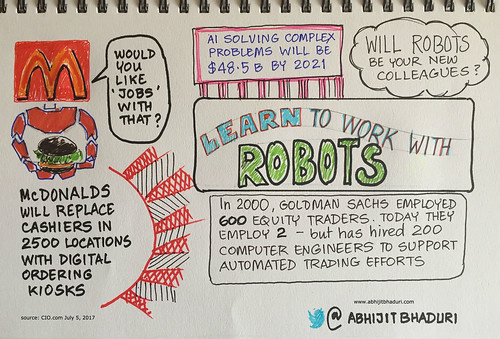 What do Japan, McDonalds and Goldman Sachs have in common? They are all pointers that should make us stop to think about the future. Let us start with Japan.What is happening to Japan could be happening to many other countries in the world. Japan’s birth rate is declining. The people are living longer and this is leading to their having to make up the gap by guest workers and students. Japan is investing heavily in building robots that can do more of what humans can. Immigration is still a bad word that frightens politicians in many countries. Japan is no exception.According to FT,
What do Japan, McDonalds and Goldman Sachs have in common? They are all pointers that should make us stop to think about the future. Let us start with Japan.What is happening to Japan could be happening to many other countries in the world. Japan’s birth rate is declining. The people are living longer and this is leading to their having to make up the gap by guest workers and students. Japan is investing heavily in building robots that can do more of what humans can. Immigration is still a bad word that frightens politicians in many countries. Japan is no exception.According to FT,
“Japan’s native population fell by a record amount in 2016, but a jump in the number of foreign residents limited the overall annual decline. According to the Internal Affairs Ministry, the number of Japanese fell 308,084 to 125.6m, reflecting decades of low birth rates and population ageing. That was offset by a 7 per cent increase in the foreign resident population to 2.3m — a rise of 148,959 people — as increasing labour shortages led to inflows of students and guest workers.”
Birth rates have been dropping. Opening the doors to immigrants poses a social challenge. Japan has been fighting to preserve its ethnic homogeneity. So the guest workers coming in to learn technical skills under the “foreign trainee” scheme have to go back in three years. Their choice for Japan is between foreign workers and robots.
McDonalds replaces McJobs
 Elsewhere, Wall Street cheered McDonald’s decision to have digital kiosks in 2500 locations to do what cashiers would. The shareholders cheered loudly and McDonalds shares hit an all-time high. The move is part of an initiative ironically named as “Experience of the Future.” These “McJobs” have funded many students and families with living wages. That may not happen for long.
Elsewhere, Wall Street cheered McDonald’s decision to have digital kiosks in 2500 locations to do what cashiers would. The shareholders cheered loudly and McDonalds shares hit an all-time high. The move is part of an initiative ironically named as “Experience of the Future.” These “McJobs” have funded many students and families with living wages. That may not happen for long.
Trading engineers
It is not just blue collared jobs that are being replaced. Goldman Sachs had 600 equity traders in 2000. Today they employ just 2 of them. Trading has become largely automated. Goldman Sachs has added 200 engineers to support automated trading. Forrester forecasted that automation will cannibalise 17% of US jobs by 2027, partly offset by the growth of 10% new jobs from the automation economy.
 AI powered robots
AI powered robots
Robots are getting better at doing many jobs. Powered by ever improving technology machines are already better than humans in some tasks like recognizing faces in photos. That could have serious implications for professions such as radiologists. Machines could get far better than a human simply because they are trained on a larger data set. Machines are trained on millions of images before the machine learns what to look for. Once it gets the hang of it, the machines keep getting better. Learning for millions of images will take humans decades. AI driven robots solving complex problems, will grow to $48.5B by 2021.While organizations have no choice but to rethink business models, they need to also start looking at reskilling their workforce. The next time you are at McDonalds and the cashier asks you, “Would you like fries with that?”, maybe you should ask, “Would you like jobs with that?”.The dilemma of Japan will be faced by several countries. Will politicians be forced to change their views on immigration? Will skill shortages force the way we view talent? Love to know your views. Do leave your comments below.=====Join me on LinkedIn and Twitter @AbhijitBhaduriWritten first for Times of India blogsLike the sketchnote? Download it and use it for free <click here>


Leave a Reply